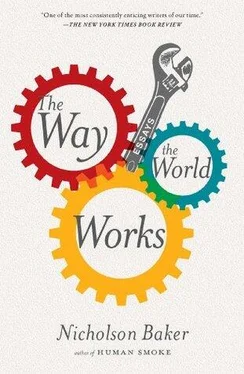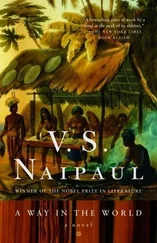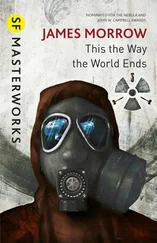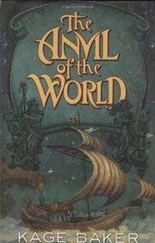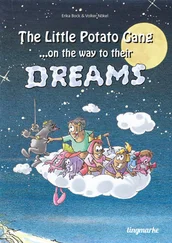Nicholson Baker - The Way the World Works
Здесь есть возможность читать онлайн «Nicholson Baker - The Way the World Works» весь текст электронной книги совершенно бесплатно (целиком полную версию без сокращений). В некоторых случаях можно слушать аудио, скачать через торрент в формате fb2 и присутствует краткое содержание. Год выпуска: 2012, Издательство: Simon & Schuster, Жанр: Публицистика, Критика, на английском языке. Описание произведения, (предисловие) а так же отзывы посетителей доступны на портале библиотеки ЛибКат.
- Название:The Way the World Works
- Автор:
- Издательство:Simon & Schuster
- Жанр:
- Год:2012
- ISBN:нет данных
- Рейтинг книги:4 / 5. Голосов: 1
-
Избранное:Добавить в избранное
- Отзывы:
-
Ваша оценка:
- 80
- 1
- 2
- 3
- 4
- 5
The Way the World Works: краткое содержание, описание и аннотация
Предлагаем к чтению аннотацию, описание, краткое содержание или предисловие (зависит от того, что написал сам автор книги «The Way the World Works»). Если вы не нашли необходимую информацию о книге — напишите в комментариях, мы постараемся отыскать её.
), here assembles his best short pieces from the last fifteen years.
The Way the World Works
OED
Modern Warfare 2
Through all these pieces, many written for
, and
, Baker shines the light of an inexpugnable curiosity.
is a keen-minded, generous-spirited compendium by a modern American master.
The Way the World Works — читать онлайн бесплатно полную книгу (весь текст) целиком
Ниже представлен текст книги, разбитый по страницам. Система сохранения места последней прочитанной страницы, позволяет с удобством читать онлайн бесплатно книгу «The Way the World Works», без необходимости каждый раз заново искать на чём Вы остановились. Поставьте закладку, и сможете в любой момент перейти на страницу, на которой закончили чтение.
Интервал:
Закладка:
When you buy the Kindle edition of Konrad Lorenz’s King Solomon’s Ring, rather than the paperback version, you save three dollars and fifty-eight cents, but the fetching illustrations by Lorenz of a greylag goose and its goslings walking out from the middle of a paragraph and down the right margin are separated from the text — the marginalia has been demarginalized. The Kindle Store offers The Cheese Lover’s Cookbook & Guide, from Simon & Schuster. “The picture of the Ricotta Pancakes with Banana-Pecan Syrup may just inspire you enough to make it the first recipe you want to try,” one happy Amazon reviewer writes. She’s referring to the recipe in the print edition, the description of which is reused in the Kindle Store — there’s no pancake picture in the Kindle version.
Yes, you can save nine dollars if you buy the Kindle edition of The Algorithmic Beauty of Seaweeds, Sponges, and Corals, by Jaap A. Kaandorp and Janet E. Kübler — it’ll cost you $85.40 delivered wirelessly, versus $94.89 in print. New Scientist says that the book is “beautifully, if sometimes eccentrically, illustrated with photographs, drawings and computer simulations.” The illustrations are there in the Kindle version, but they’re exceedingly hard to make out, even if you zoom in on them using the five-way clicker switch, or “control nipple,” as one Kindler called it. An award-winning medical textbook titled Imaging in Oncology (second edition) is for sale in the Kindle Store for $287.96. Tables are garbled. The color coding — yellow for malignancy, blue for healthy tissue — has been lost. Arrows pointing to shadowy tumors become invisible in the gray. Indeed, the tumors themselves disappear.
One more expensive example. The Kindle edition of Selected Nuclear Materials and Engineering Systems, an e-book for people who design nuclear power plants, sells for more than eight thousand dollars. Figure 2 is an elaborate chart of a reaction scheme, with many callouts and chemical equations. It’s totally illegible. “You Save: $1,607.80 (20 %),” the Kindle page says. “I’m not going to buy this book until the price comes down,” one stern Amazoner wrote.
Here’s what you buy when you buy a Kindle book. You buy the right to display a grouping of words in front of your eyes for your private use with the aid of an electronic display device approved by Amazon. The company uses an encoding format called Topaz. ( Topaz is also the name of a novel by Leon Uris, not available at the Kindle Store.) There are other e-book software formats — Adobe Acrobat, for instance, and Microsoft Reader, and an open format called ePub — but Amazon went its own way. Nobody else’s hardware can handle Topaz without Amazon’s permission. That means you can’t read your Kindle books on your computer, or on an e-book reader that competes with the Kindle. (You can, however, read Kindle books on the iPod Touch and the iPhone — more about that later — because Amazon has decided that it’s in its interest to let you.) Maybe you’ve heard of the Sony Reader? The Sony Reader’s page-turning controls are better designed than the Kindle’s controls, and the Reader came out more than a year before the Kindle did; also, its screen is slightly less gray, and its typeface is better, and it can handle ePub and PDF documents without conversion, but forget it. You can’t read a Kindle book on a Sony machine, or on the Ectaco jetBook, the BeBook, the iRex iLiad, the Cybook, the Hanlin V2, or the Foxit eSlick. Kindle books aren’t transferable. You can’t give them away or lend them or sell them. You can’t print them. They are closed clumps of digital code that only one purchaser can own. A copy of a Kindle book dies with its possessor.
On the other hand, there’s no clutter, no pile of paperbacks next to the couch. A Kindle book arrives wirelessly: it’s untouchable; it exists on a higher, purer plane. It’s earth-friendly, too, supposedly. Yes, it’s made of exotic materials that are shipped all over the world’s oceans; yes, it requires electricity to operate and air-conditioned server farms to feed it; yes, it’s fragile and it duplicates what other machines do; yes, it’s difficult to recycle; yes, it will probably take a last boat ride to a Nigerian landfill in five years. But no tree farms are harvested to make a Kindle book; no ten-ton presses turn, no ink is spilled.
Instead of ink on paper, there’s something called Vizplex. Vizplex is the trade name of the layered substance that makes up the Kindle’s display — i.e., the six-inch-diagonal rectangle that you read from. It’s a marvel of bi-stable microspheres, and it took lots of work and more than 150 million dollars to develop, but it’s really still in the prototype phase. Vizplex, in slurry form, is made in Cambridge, Massachusetts, by a company called E Ink. E Ink layers it onto a film, or “frontplane laminate,” at a plant in western Massachusetts, and then sends the laminate to Taiwan, where its parent company, P.V.I. (which stands for Prime View International, itself a subsidiary of a large paper company), marries it to an electronic grid, or backplane. The backplane tells the frontplane what to do.
The prospect of Vizplex first arose in the mind of a scientist, Joseph Jacobson, who now works at M.I.T.’s Media Lab and avoids interviews on the subject of e-paper. Sometime in the mid-nineties, according to a colleague, Jacobson was sitting on a beach reading. He finished his book. What next? He didn’t want to walk off the beach to get another book, and he didn’t want to lie on the beach and dig moist holes with his feet, thinking about the algorithmic beauty of seaweeds. What he wanted was to push a little button that would swap the words in the book he held for the words in some other book somewhere else. He wanted the book he held to be infinitely rewriteable — to be, in fact, the very last book he would ever have to own. He called it “The Last Book.” To make the Last Book, he would have to invent a new kind of paper: RadioPaper.
At M.I.T., Jacobson and a group of undergraduates made lists of requirements, methods, and materials. One of their tenets was: RadioPaper must reflect, like real paper. It must not emit. It couldn’t be based on some improved type of liquid-crystal screen, no matter how high its resolution, no matter how perfectly jewel-like its colors, no matter how imperceptibly quick its flicker, because liquid crystals are backlit, and backlighting, they believed, is intrinsically bad because it’s hard on the eyes. RadioPaper also had to be flexible, they thought, and it had to persist until recycled in situ. It should hold its image even when it drew no current, just as paper could. How to do that? One student came up with the idea of a quilt of tiny white balls in colored dye. To make the letter A, say, microsquirts of electricity would grab some of the microballs and pull them down in their capsule, drowning them in the dye and making that capsule and neighboring capsules go dark and stay dark until some more electricity flowed through in a second or a day or a week. This was the magic of electrophoresis.
In 1997, Jacobson and his partners joined with Russ Wilcox, an entrepreneur from Harvard Business School, to form E Ink. “When we first got involved with this, people were, like, ‘Oh, you’re trying to kill the book,’” Wilcox said recently, by telephone. “And we’re, like, ‘No, we love the book.’ Unfortunately, we fear for its future, because people just expect digital media these days. The economic pressures are immense.”
The newspaper industry, Wilcox figured, was a 180-billion-dollar-a-year business, and book publishing was an additional 80 billion. Half of that was papermaking, ink mixing, printing, transport, inventory, and the warehousing of physical goods. “So you can save a hundred and thirty billion dollars a year if you move the information digitally,” he told me. “There’s a lot of hidden forces at work that are all combining to make this sort of a big tidal wave that’s coming.”
Читать дальшеИнтервал:
Закладка:
Похожие книги на «The Way the World Works»
Представляем Вашему вниманию похожие книги на «The Way the World Works» списком для выбора. Мы отобрали схожую по названию и смыслу литературу в надежде предоставить читателям больше вариантов отыскать новые, интересные, ещё непрочитанные произведения.
Обсуждение, отзывы о книге «The Way the World Works» и просто собственные мнения читателей. Оставьте ваши комментарии, напишите, что Вы думаете о произведении, его смысле или главных героях. Укажите что конкретно понравилось, а что нет, и почему Вы так считаете.
